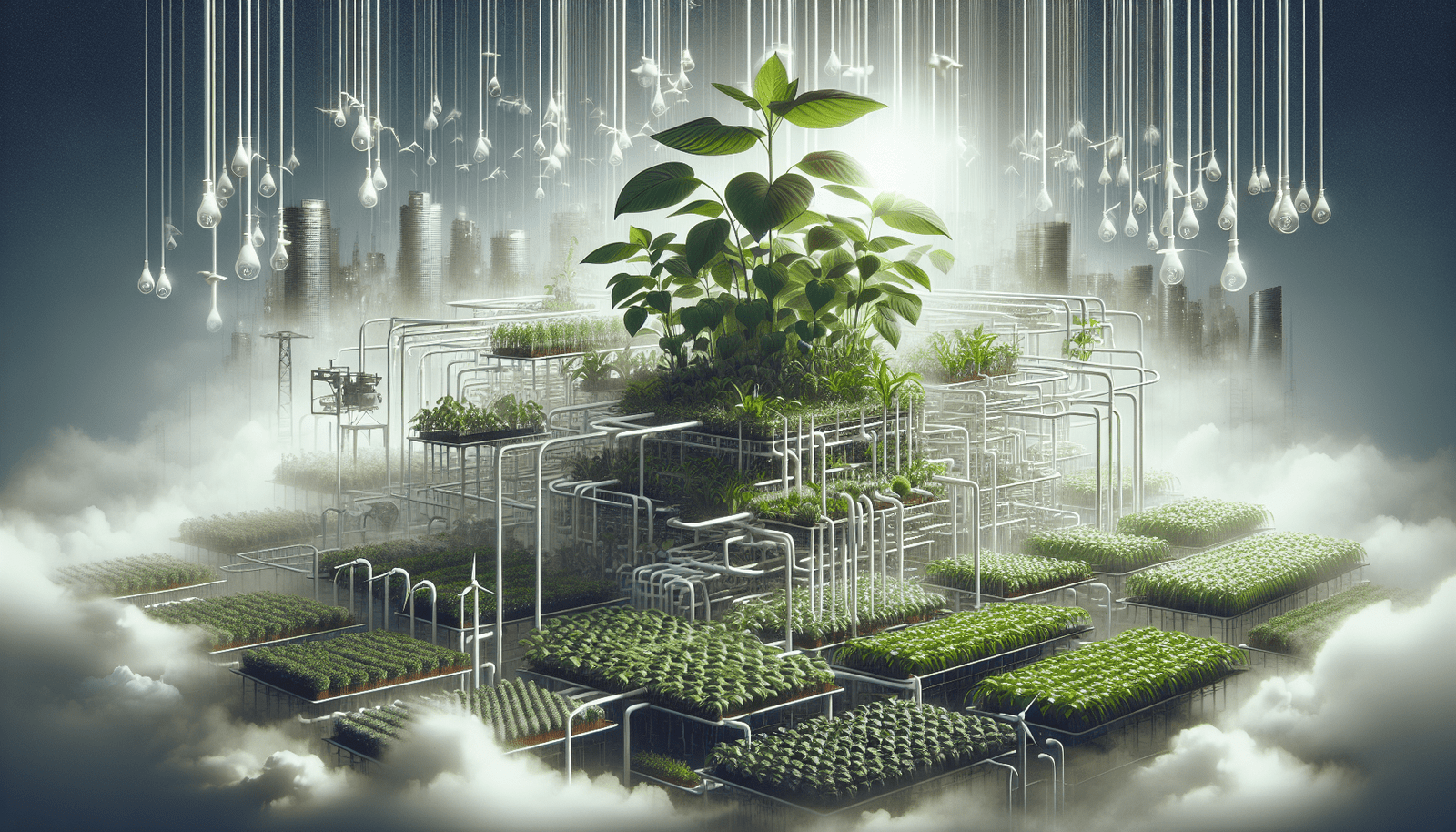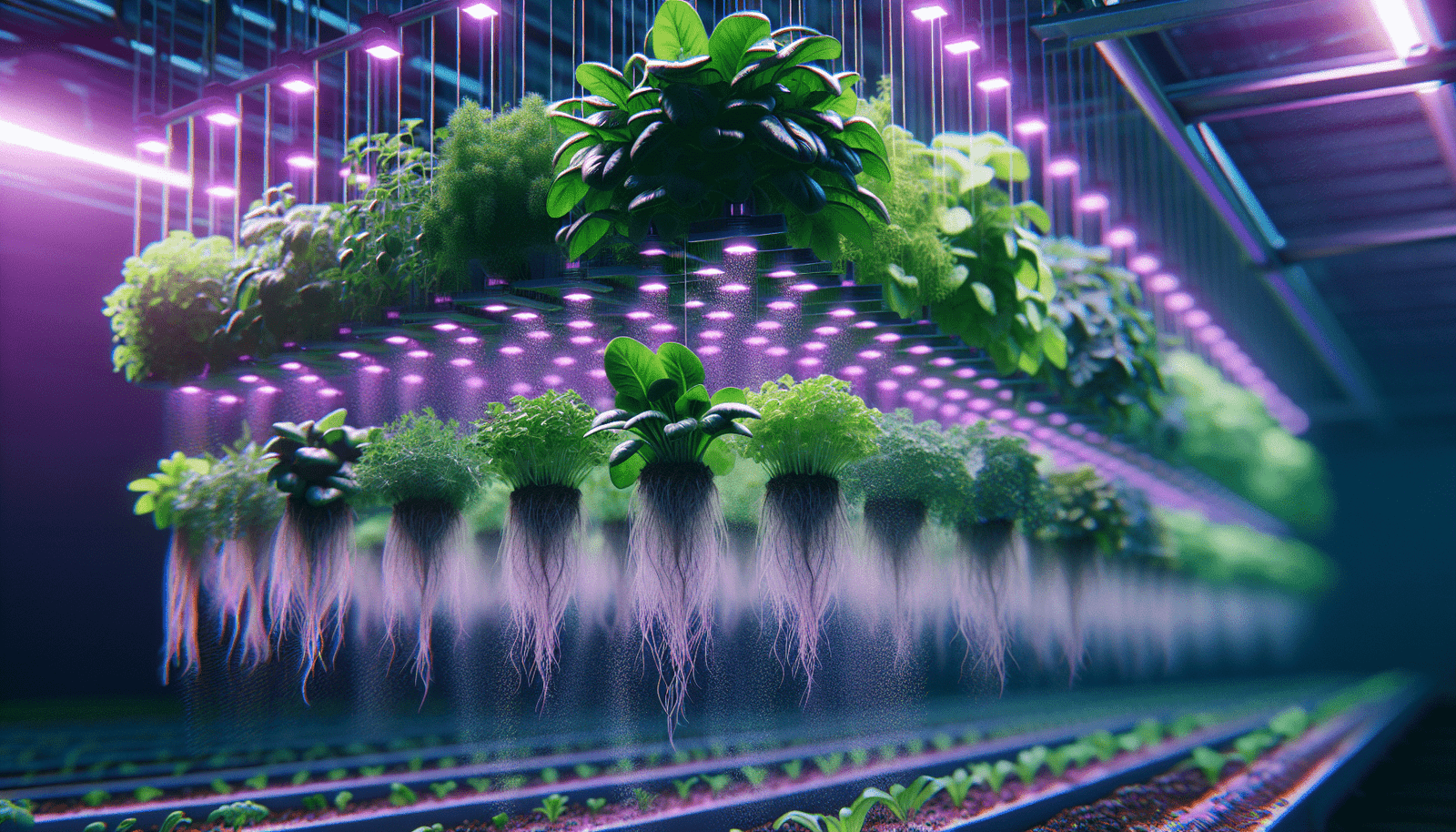Are you tired of traditional gardening methods and looking for a more efficient and sustainable alternative? Look no further than aeroponics. This innovative method of cultivating plants without soil has taken the agricultural industry by storm, offering numerous benefits that will surely pique your interest. From faster growth rates to higher crop yields and reduced water usage, aeroponics holds the key to a greener and more productive future. Discover the wonders of aeroponics and unlock the potential of this groundbreaking technology.
Understanding Aeroponics
Definition of aeroponics
Aeroponics is a soilless form of agriculture that involves growing plants in a misted environment without the use of any soil or growing medium. Instead, the plant roots are suspended in air and periodically sprayed with a nutrient-rich solution. This innovative method of farming allows for the efficient delivery of nutrients and water directly to the roots, promoting faster plant growth and increased crop yields.
Overview of how aeroponics system works
In an aeroponics system, plants are usually grown in vertical units or racks, where the roots hang freely in the air. Nutrient-rich water is misted onto the roots at regular intervals, ensuring that they receive the necessary moisture and nutrients they need to thrive. The misting process creates a highly oxygenated environment around the roots, which stimulates their growth and encourages rapid plant development. This unique setup also allows for precise control over environmental factors such as temperature, humidity, and nutrient balance, further enhancing plant growth and health.
Improved Crop Yield
How aeroponics encourages faster plant growth
Aeroponics provides plants with increased access to oxygen, thanks to the suspended root system. This excess oxygen availability promotes healthier root development and higher absorption of nutrients, resulting in faster growth rates compared to traditional farming methods. With access to abundant oxygen, plants can allocate more energy towards above-ground growth, producing larger and healthier fruits, vegetables, and herbs.
Ability of aeroponics to produce year-round crops
One of the significant advantages of aeroponics is its ability to support year-round crop production, regardless of weather conditions or seasonal limitations. With aeroponics, plants can be grown in controlled indoor environments, allowing optimal conditions to be maintained throughout the year. This means that farmers can achieve consistent crop yields regardless of the external climate, ensuring a reliable and steady supply of fresh produce.

Lesser Water and Nutrient Usage
Efficiency of aeroponic system in utilizing water
Aeroponics outperforms traditional farming methods in terms of water efficiency. In a conventional agricultural system, much of the water applied to the soil is lost through runoff or evaporation. In contrast, aeroponics requires significantly less water due to its precise misting system, which delivers water directly to the roots. The reduced water usage not only conserves this increasingly scarce resource but also minimizes the environmental impact caused by excessive irrigational practices.
How aeroponics reduces nutrient usage
Aeroponics minimizes nutrient wastage by delivering nutrients directly to the plant roots in a highly efficient manner. The misting process ensures that the nutrients are precisely targeted, eliminating the need for excessive application and reducing the amount of fertilizer required. This focused delivery system not only saves on costs but also prevents nutrient runoff, protecting water sources from contamination. Additionally, the controlled environment of aeroponics allows for the optimal uptake and utilization of nutrients by the plants, maximizing their overall growth and health.
Space Efficiency
The vertical stacking capacity in aeroponics
Aeroponic systems make efficient use of space by allowing plants to be grown vertically. Racks or stacking units can be utilized to create multiple layers, increasing the plant volume per square meter. This vertical stacking capacity means that aeroponic farms require considerably less land than traditional farming methods to achieve the same crop yield. As urban areas face increasing land constraints, the space-saving aspect of aeroponics makes it an appealing solution for urban farming and indoor agriculture.
Benefits for urban and indoor farming
The space-saving benefits of aeroponics make it an ideal method for urban and indoor farming. With limited available land in cities, aeroponic systems can be implemented in vertical farming setups, transforming underutilized spaces into productive food production areas. The controlled environment of indoor farming also allows for year-round crop growth, independent of external factors such as weather or seasonality. By bringing agriculture closer to urban centers, aeroponic farming reduces the carbon footprint associated with transporting produce from rural areas, contributing to a more sustainable and locally sourced food supply.

Lower Risk of Disease and Pests
Reduction of pest and disease attacks
One of the significant advantages of aeroponics is the reduced risk of pest and disease infestation. Because aeroponics eliminates the use of soil, many soil-borne pests and diseases are inherently minimized. Additionally, the suspended root system and controlled environment of aeroponics make it harder for pests and diseases to gain a foothold. The absence of soil also eliminates the need for chemical soil treatments, further reducing the risk of contamination and minimizing the reliance on harmful pesticides.
Advantages of less chemical fertilizers and pesticides
Aeroponics minimizes the need for chemical fertilizers and pesticides, making it an environmentally friendly growing method. The precise delivery of nutrients in aeroponics ensures that plants receive an optimal balance, reducing the reliance on synthetic fertilizers. Furthermore, the controlled environment and absence of soil create natural barriers against pests and diseases, reducing the need for chemical pesticides. This reduction in chemical inputs results in cleaner and safer produce, promoting healthier lifestyles and a more sustainable agricultural system.
Better Control over Growing Conditions
Ability to control temperature and humidity
Aeroponics offers precise control over environmental factors such as temperature and humidity, allowing farmers to create ideal conditions for plant growth. By maintaining optimal levels, crops can thrive and develop at an accelerated pace, resulting in enhanced yields. This level of control also enables farmers to experiment with growing conditions and adjust variables to optimize plant growth for specific crops, ensuring the best possible harvests.
Control over nutrient balance
With aeroponics, farmers have complete control over the nutrient balance delivered to the plants. By accurately monitoring the nutrient solution composition and adjusting it as needed, growers can ensure that plants receive the right amounts of essential elements and trace minerals. This level of control allows for precise adjustments tailored to the specific needs of each plant type, promoting optimal growth and nutrient uptake. The ability to fine-tune nutrient delivery ensures that crops are not overfertilized, minimizing nutrient wastage and environmental impact.
Improved Plant Health and Nutrient Content
Better access to oxygen leading to healthier plants
Aeroponics provides plants with increased access to oxygen, resulting in healthier and more robust plant growth. The suspended root system allows for better oxygenation, as the roots are not compacted within soil particles. This abundant oxygen availability enhances nutrient absorption, root development, and overall plant vigor. The improved plant health translates into higher crop yields and superior-quality produce.
Increased nutrient content in aeroponically grown crops
Not only does aeroponics promote healthier plants, but it also leads to increased nutrient content in crops. The precise delivery of nutrients in the aeroponic system ensures that plants have access to an optimal balance of essential minerals. Research has shown that aeroponically grown crops often contain higher levels of vitamins, antioxidants, and phytochemicals compared to conventionally grown produce. This nutritional advantage makes aeroponics an appealing choice for health-conscious consumers seeking nutrient-dense food options.
Environmental Implications of Aeroponics
Reduction in water pollution
Aeroponics significantly reduces the risk of water pollution compared to conventional farming methods. By minimizing the use of water and carefully targeting nutrient delivery, the chance of excessive runoff or leaching of fertilizers and chemicals into water bodies is greatly reduced. This reduction in water pollution safeguards aquatic ecosystems, protects drinking water sources, and contributes to the preservation of biodiversity.
Lesser soil degradation
Conventional agriculture often leads to soil degradation due to excessive tillage, erosion, and nutrient depletion. However, aeroponics completely eliminates the need for soil, thereby preventing any form of soil degradation. By adopting an aeroponic system, farmers can preserve valuable topsoil, which is essential for sustaining fertile agricultural land. This approach promotes the long-term health and productivity of the soil, making aeroponics a sustainable and environmentally friendly farming practice.
Economic Benefits of Aeroponics
Lower operational costs
Aeroponics can offer lower operational costs compared to traditional farming methods. The efficient use of water, reduced need for fertilizers and pesticides, and space-saving characteristics contribute to overall cost savings. Additionally, the controlled environment and vertical stacking capacity of aeroponics allow for increased crop density and production per square meter, maximizing the value derived from limited land resources.
Higher profitability due to larger crop yields
Aeroponics enables farmers to achieve higher crop yields compared to conventional farming methods, thereby increasing profitability. The faster growth rates, year-round crop production, and enhanced plant health all contribute to larger harvests. The ability to consistently supply fresh produce, regardless of seasonal limitations, also allows for increased market competitiveness and potential premium pricing. These economic advantages make aeroponics an attractive option for farmers looking to maximize their profitability and viability in the agricultural industry.
Challenges and Solutions in Aeroponic Farming
Technical challenges and ways to overcome them
Aeroponic farming does come with its fair share of technical challenges. Maintaining the misting system and ensuring consistent and even nutrient delivery can be demanding. However, advances in automation and sensor technology have addressed many of these challenges. Automated misting systems, nutrient monitoring sensors, and pH controllers have made the management of aeroponic systems easier and more efficient. Implementing regular maintenance schedules and investing in reliable equipment can help farmers overcome these technical obstacles and ensure the smooth operation of their aeroponic farms.
Addressing failures in the aeroponic system
Failures in the aeroponic system, such as power outages or equipment malfunctions, can pose risks to crop health and yield. However, backup power sources and redundant systems can be implemented to mitigate such risks. A well-designed aeroponic system should take into account potential failures and include appropriate fail-safe measures. Additionally, continuous monitoring and regular inspections can help identify and address any issues promptly, minimizing the impact on crop production. By being proactive and prepared, farmers can effectively address failures and ensure the overall success of their aeroponic operations.
In conclusion, aeroponics offers a sustainable and innovative approach to agriculture, providing numerous benefits compared to traditional farming methods. With improved crop yield, reduced water and nutrient usage, efficient space utilization, lower disease and pest risks, better control over growing conditions, improved plant health, and nutrient content, as well as positive environmental and economic implications, aeroponics presents a promising solution for the future of farming. By embracing this technology, farmers can maximize their productivity, protect the environment, and meet the growing demand for nutritious and sustainable food.
